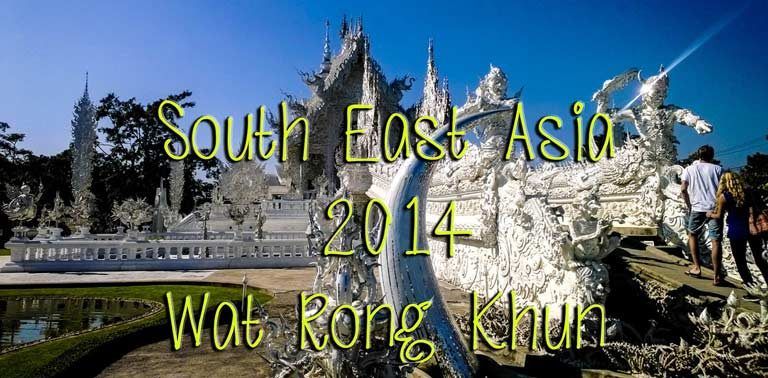
Travel Diary: South East Asia 2013-14 (Part 2)
 In this second part of our SEA travel diary from mid-Dec 2013 to mid-Jan 2014 we continue from Ho Chi Ming City in Vietnam to Hue, explore Laos and spend still some time in Thailand.
In this second part of our SEA travel diary from mid-Dec 2013 to mid-Jan 2014 we continue from Ho Chi Ming City in Vietnam to Hue, explore Laos and spend still some time in Thailand.
Did you already check out the first part of the travel diary from Bangkok to HCMC through Cambodia?
From HCMC to Hue by train
After couple of days in Ho Chi Minh, our next destination in Vietnam was Hue, a historical town located in the central region of Vietnam near the coast, bit over 1000 kilometers north from HCMC. Train traveling in Vietnam is not very fast; it took 20 hours to reach Hue, but even in the cheapest “hard sleeper” coach with 6 beds the journey was bearable (overnight train ticket 48 $) and nice views were part of the package. We actually even slept quite well, although it was a bit cold at night and there was not much of a mattress in the bed.
When planning the trip, we must have been unaware that Hue is infamous for its weather. It tends to be wet and misty almost throughout the year due to the mountain area nearby that is affecting the weather in Hue. City itself has long and colorful past, and there are lot of interesting sights, such as Imperial Citadel and Tombs of emperors. Easy way to move around is to rent bicycles, and cycling also helped us to keep ourselves warm, since we didn’t have that much long-sleeves with us.
Crossing the border to Laos
Couple of days was enough in rainy Hue, and then it was time to move forward to Laos. If only we would have had more time, we would have visited also the northern part of Vietnam. Maybe next time then. We bought our bus tickets to Savannakhet straight from Hue bus station (around 13 $), as the price was much higher in the town. Ride to Lao Bao border crossing was relatively quick. When on the border, our bus driver let us all out with our bags, and continued with an empty bus to the other side. It took us a while to get through passport checks and queue to the visa on arrival (30 $ to us) desk, but overall it was a nice and easy crossing. At least until we realized in Laos side, that our bus was nowhere to be seen, which made us a “bit” nervous, thinking that we had been left behind.
Luckily we soon recognized some other passengers from the same bus, so at least we knew that we weren’t the only ones in trouble. With some asking around we found out that buses usually drive to some service station around 1 km further. Would have been nice to be informed beforehand of course… There were guys offering a moto-ride (surprise…), but we naturally decided to walk along the road, and found the bus in less than 10 minutes. Back in, and towards Savannakhet, slowly on poor maintained roads, but with nice landscapes along the way.
Savannakhet and Vientiane in Laos
Savannakhet is the second largest city in Laos after the capital Vientiane. It’s located in southern part of the country along the Mekong river, so it is neighboring Thailand. We got a nice hostel room for just around 10 dollars, and headed to explore the city center that is small enough to explore on foot. We ate well and after that, by following loud music coming from somewhere near, we accidentally took part in some Tiger Beer Countdown 2014 festival. Well, some cold beer with live music and relaxed atmosphere never harms, right? On the next day, it was New Year’s Eve, and we celebrated it by hanging out by the river and watching the fireworks. In New Year’s Day we learned that in Laos public holidays are taken quite seriously; it was pretty hard to find any open restaurants or shops. Even in our guesthouse no-one was working, at least not at the time we tried to check out.
Our next target was Vang Vieng in the northern part of the country, so we bought bus tickets first to Vientiane, which works as a transportation hub to different parts of the country. Tickets to local sleeper bus cost around 30 $, but the price included real beds with proper mattresses, pillows, blankets and water bottles. Not a bad deal, though the size of the bed was a bit of a challenge especially for Toni. In Vientiane, we spent couple of morning hours wandering around the city and comparing prices of bus and minivan rides to Vang Vieng. Best deal that we found from tour offices was under 5 $, surely some local transportation would have been even cheaper, but this time we didn’t want to take the slowest option.
Picturesque Vang Vieng and Luang Prapang
Vang Vieng used to be famous for herds of young, drunk tourists river tubing and partying hard with cheap drink buckets. That would not have been our cup of tea, but we were interested in the stunning environment around the city and the outdoor activities instead. Luckily the place is no longer such a party headquarters as before, though of course still a popular tourist destination. The limestone karst mountains across the river are an awesome sight and home to several impressive caves. There are some nice paths and dirt roads to hike and bike around the area. Strong recommendation for buying a local map and hitting the trails and exploring the caves also. We stayed two days in Vang Vieng and the surroundings before continuing by bus (ticket ~10 $) to Luang Prabang, the former capital of Laos and a UNESCO World Heritage city.
Route from Vang Vieng to Luang Prabang is mountainous and bumpy, and since our ride was a smallish mini van that we shared with 7 other passengers, 6 hours felt long and sweaty. First task in Luang Prapang was once again to try to find some cheap accommodation (and get a shower…). After some spinning around we ended up staying in Pathoum Phone Guesthouse, which was very affordable (9$ per night for a double room) but somewhat run-down. We had no particular agenda for our stay in Luang Prapang, other than finding out how reserve a slow boat via Pak Beng to Huay Xai next to the border to Thailand. But it was enough just to wander along the city admiring the architecture and surroundings and enjoying the eatables from street stalls and night market.
2-days Mekong slow boat ride
Regarding the slow boat trip, we decided to take a risk and not to purchase the tickets beforehand, since the prices that the travel agencies and other vendors in town suggested sounded too high. So what we did, was to get up early and take a tuk-tuk ride to the ferry pier, which was surprisingly far away from the city center. Luckily there was no problem with buying the tickets from the pier before boarding, and the cost for the first part of the trip to Pak Beng was 110 000 KIP, which is around 14 $ per one ticket.
The Mekong slow boat was a really nice and relaxing way of transportation. There was around 70 seats in the boat, mostly with tables, and there was a small booth that offered coffee and some snacks like sticky rice and cup noodles. Which was a relief, since we didn’t have any food with us and there was no shops in the ferry peer. The trip to Pak Beng took basically the whole day, but still wasn’t boring at all since riverside landscapes were beautiful and we had books to read. Pak Beng was just a stopover for us, so we chose a cheap hostel for one night and ate some dinner. In the evening, when sitting next to the river and enjoying beers we witnessed how some locals dumped their waste, straight to the river, how sad is that 🙁
From Huay Xai to Chiang Rai in Thailand
Next morning we again hopped in a boat and bought tickets to Huay Xai, which borders a Thai city Chiang Khong. Day passed by in the same way than the previous, and around 6 pm we reached Huay Xai. Found out that new border crossing along a bridge had just been opened (the previous way was to cross the river by small boats) and took a tuk-tuk ride with some other tourists to the bridge around 10 km from the town. It was really easy and quick crossing, and so we were back in Thailand, for the first time in the northern part of the country. It was too late in the evening to get a bus to Chiang Rai the same day, so we spent the night in some bottom-priced hostel and continued the next morning.
Our stay in the Chiang Rai was again short, but we still had time to wander around the city, have a hot and sweaty morning run, eat excellent local dishes in street food stalls and check out the incredible Wat Rong Khun, the White Temple. Wat Rong Khun is a unique temple that stands out through the white color and the use of pieces of glass in the plaster, sparkling in the sun. The white color signifies the purity of the Buddha, while the glass symbolizes the Buddha’s wisdom and the Dhamma, the Buddhist teachings.
Relaxing in Ko Sichang and some turbulence in Bangkok
Since we still wanted to have some beach time before going back to the winter in Finland, we decided to skip Chiang Mai this time and take a night bus to Bangkok to be able to pay a couple of days visit to Ko Sichang island southeast from the capital. To get there we took a bus from Bangkok eastern bus station Ekkamai to the city of Si Racha, from where the boats to Ko Sichang leave (Koh Loi pier). Ko Sichang is quite small island and definitely not such paradise as many other islands in Thailand. But for the purpose of getting still some tan and just relaxing not far away Bangkok, it serves just fine. There are some temples and caves to explore and some decent snorkeling places, and the sunsets were awesome! We had time to stay for three days before heading back to the capital.
We took a mini-van ride from Si Racha, and ended up somewhere close to the northern bus station in Bangkok. We hadn’t booked any accommodation beforehand, so found ourselves walking around with backpacks, sweaty, hungry and in desperate need to use a toilet, trying to find some decent options… Not a first time that has happened, and the solution was to sit down in some cafe with wifi and use the internet to find a hostel. Our pick was a place called Urban Age in Silom, a bit pricey to our budget (~21 $) but at least we avoid the hustle and bustle of Khao San Road and the area. When walking around in Silom it was obvious that some political turbulence was ongoing before the election to come. Actually, when checked from Ministry for foreign affairs of Finland travelling abroad pages, going to Bangkok was not recommended at all at that moment, and some people had even lost their lives in conflicts. But we felt quite safe still, when avoiding the places with lot of crowds gathered together. And actually the parades on the streets with flags and music looked more like a festival than a protest.
Since part of the malls, shops and even some metro stations were closed due to the ongoing situation, we didn’t really have a chance for last-minute shopping, and had to reserve some extra time for getting to the airport. Luckily sky trains were working normally, and after all it was fast and easy to reach Suvarnabhumi Airport via public transportation. Then a long way back home via Kuala Lumpur and London, already planning the next holidays in the plane, as usual!
Thinking back now, our schedule on this SEA round trip was just crazy. But that’s what happens when you try to see as much as possible during few holiday weeks. We definitely will be visiting all these four countries again, with more time to spend.






